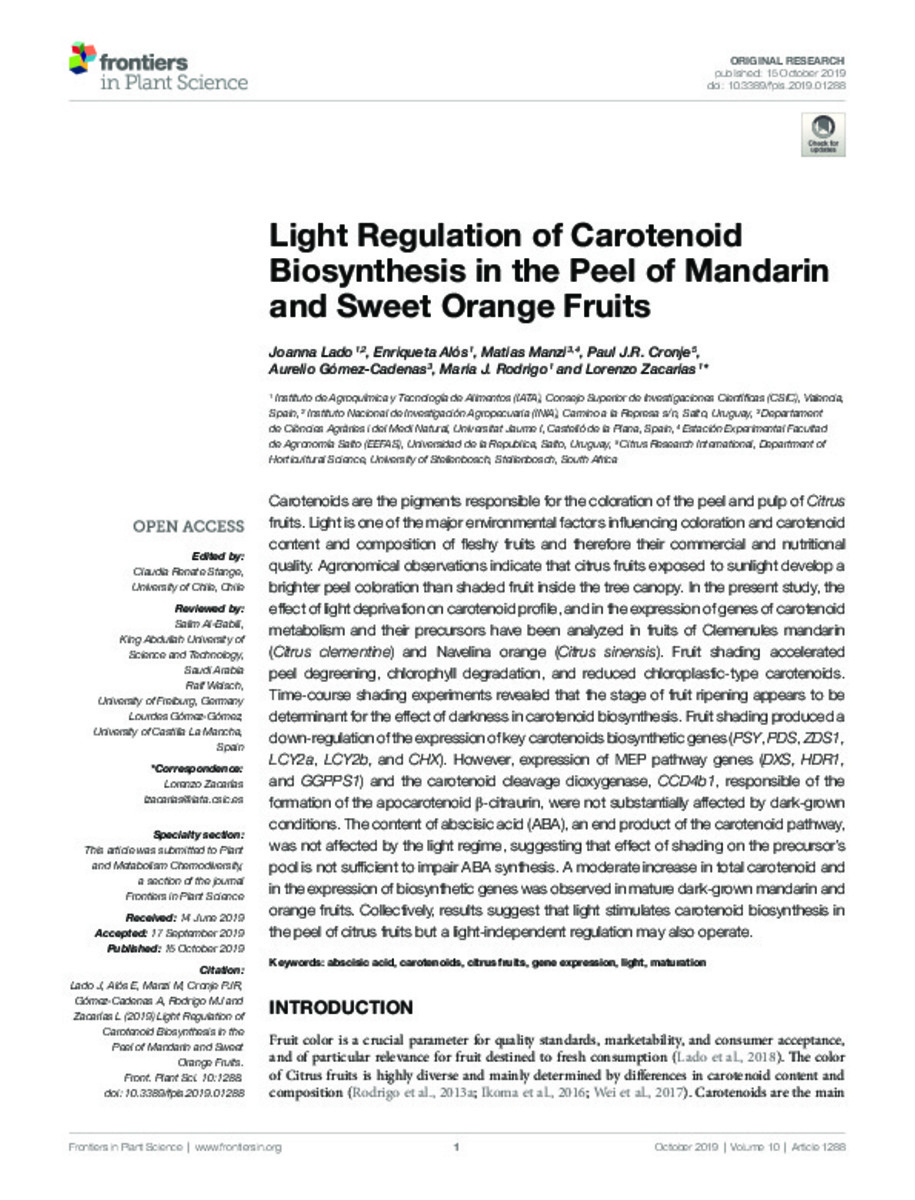Mostrar el registro sencillo del ítem
Light Regulation of Carotenoid Biosynthesis in the Peel of Mandarin and Sweet Orange Fruits
| dc.contributor.author | Lado, Joanna | |
| dc.contributor.author | Alós, Enriqueta | |
| dc.contributor.author | Manzi Fraga, Matías Jesús | |
| dc.contributor.author | Cronje, Paul | |
| dc.contributor.author | Gomez-Cadenas, Aurelio | |
| dc.contributor.author | Rodrigo, María Jesús | |
| dc.contributor.author | Zacarías, Lorenzo | |
| dc.date.accessioned | 2020-03-31T11:59:32Z | |
| dc.date.available | 2020-03-31T11:59:32Z | |
| dc.date.issued | 2019-10-15 | |
| dc.identifier.citation | LADO, Joanna; ALÓS,Enriqueta; MANZI FRAGA, María Jesús; CRONJE, Paul; GÓMEZ CADENAS, Aurelio; RODRIGO, María Jesús; ZACARÍAS, Lorenzo (2019). Light Regulation of Carotenoid Biosynthesis in the Peel of Mandarin and Sweet Orange Fruits. Frontiers in Plant Science, v. 10 | ca_CA |
| dc.identifier.uri | http://hdl.handle.net/10234/187251 | |
| dc.description.abstract | Carotenoids are the pigments responsible for the coloration of the peel and pulp of Citrus fruits. Light is one of the major environmental factors influencing coloration and carotenoid content and composition of fleshy fruits and therefore their commercial and nutritional quality. Agronomical observations indicate that citrus fruits exposed to sunlight develop a brighter peel coloration than shaded fruit inside the tree canopy. In the present study, the effect of light deprivation on carotenoid profile, and in the expression of genes of carotenoid metabolism and their precursors have been analyzed in fruits of Clemenules mandarin (Citrus clementine) and Navelina orange (Citrus sinensis). Fruit shading accelerated peel degreening, chlorophyll degradation, and reduced chloroplastic-type carotenoids. Time-course shading experiments revealed that the stage of fruit ripening appears to be determinant for the effect of darkness in carotenoid biosynthesis. Fruit shading produced a down-regulation of the expression of key carotenoids biosynthetic genes (PSY, PDS, ZDS1, LCY2a, LCY2b, and CHX). However, expression of MEP pathway genes (DXS, HDR1, and GGPPS1) and the carotenoid cleavage dioxygenase, CCD4b1, responsible of the formation of the apocarotenoid β-citraurin, were not substantially affected by dark-grown conditions. The content of abscisic acid (ABA), an end product of the carotenoid pathway, was not affected by the light regime, suggesting that effect of shading on the precursor’s pool is not sufficient to impair ABA synthesis. A moderate increase in total carotenoid and in the expression of biosynthetic genes was observed in mature dark-grown mandarin and orange fruits. Collectively, results suggest that light stimulates carotenoid biosynthesis in the peel of citrus fruits but a light-independent regulation may also operate. | ca_CA |
| dc.format.extent | 16 p. | ca_CA |
| dc.format.mimetype | application/pdf | ca_CA |
| dc.language.iso | eng | ca_CA |
| dc.publisher | Frontiers Media | ca_CA |
| dc.relation.isPartOf | Frontiers in Plant Science (2019), v. 10 | ca_CA |
| dc.rights | Atribución 4.0 Internacional | * |
| dc.rights.uri | http://creativecommons.org/licenses/by-sa/4.0/ | * |
| dc.subject | Abscisic acid | ca_CA |
| dc.subject | Carotenoids | ca_CA |
| dc.subject | Citrus fruits | ca_CA |
| dc.subject | Gene expression | ca_CA |
| dc.subject | Light | ca_CA |
| dc.subject | Maturation | ca_CA |
| dc.title | Light Regulation of Carotenoid Biosynthesis in the Peel of Mandarin and Sweet Orange Fruits | ca_CA |
| dc.type | info:eu-repo/semantics/article | ca_CA |
| dc.identifier.doi | https://doi.org/10.3389/fpls.2019.01288 | |
| dc.relation.projectID | 1) Research grants AGL2012-34576 and AGL2015-70218 (Ministerio Economía y Competitividad, Spain); 2) Eurocaroten (COST_Action CA15136); 3) (Spanish Carotenoid Network BIO2017-90877-REDT, Ministerio de Ciencia, Innovación y Universidades, Spain | ca_CA |
| dc.rights.accessRights | info:eu-repo/semantics/openAccess | ca_CA |
| dc.relation.publisherVersion | https://www.ncbi.nlm.nih.gov/pmc/articles/PMC6803510/ | ca_CA |
| dc.type.version | info:eu-repo/semantics/publishedVersion | ca_CA |
Ficheros en el ítem
Este ítem aparece en la(s) siguiente(s) colección(ones)
-
CAMN_Articles [566]








